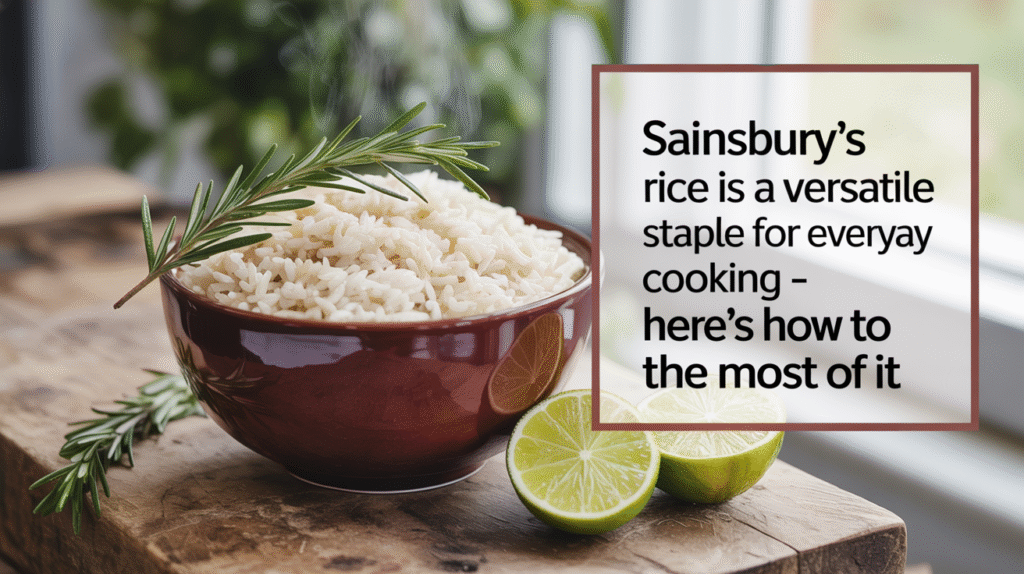Sainsbury’s Rice is one of the most versatile and affordable staples you can keep in your kitchen. Whether you’re preparing simple steamed rice or experimenting with biryani, risotto, or fried rice, the right type of rice makes all the difference. With a wide range of options available—from long grain to jasmine and basmati—Sainsbury’s offers high-quality rice suited for every recipe and occasion.

Types of Sainsbury’s Rice and Their Culinary Uses
Each type of rice brings unique texture, aroma, and performance to the table. Understanding their strengths can help you choose the best one for your meals.
Basmati Rice
A long-grain rice known for its aromatic fragrance and fluffy texture.
- Ideal for curries, biryani, and pilaf.
- Absorbs flavours well while maintaining separation of grains.
Long Grain Rice
Common for everyday cooking due to its neutral flavour and non-sticky texture.
- Perfect for stir-fries, rice bowls, and casseroles.
- Holds shape well and doesn’t clump easily.
Jasmine Rice
Fragrant and slightly sticky, jasmine rice is popular in Thai and Southeast Asian dishes.
- Excellent for coconut rice, curries, and grilled meat dishes.
- Naturally aromatic with a soft, moist texture.
Short Grain Rice
Sticky and slightly chewy, short grain rice is great for sushi and rice puddings.
- Used in Japanese cuisine and some desserts.
- Clumps together for easy rolling and moulding.
Brown Rice
A whole grain variety that retains the bran and germ layers.
- Rich in fibre and nutrients.
- Ideal for healthier rice dishes, grain bowls, and salads.
Why Choose Sainsbury’s Rice?
Sainsbury’s rice range is known for its consistent quality, affordability, and diverse offerings, making it easy to find the right fit for every dish.
Trusted Quality and Sourcing
Sainsbury’s works with established suppliers to ensure consistent grain quality.
- Regularly tested for moisture levels, cleanliness, and aroma.
- Many rice types sourced from traditional growing regions such as India and Thailand.
Clear Labelling and Packaging
Sainsbury’s rice comes with cooking instructions and storage advice.
- Available in resealable bags and economy packs.
- Easy-to-read labels for identifying rice type and best uses.
Cooking with Sainsbury’s Rice for Best Results
Cooking rice correctly is just as important as choosing the right variety.
Rinse Before Cooking
Rinsing removes surface starch that can cause clumping.
- Place rice in a sieve and rinse under cold water until clear.
- Rinsing also helps remove dust or residual husks.
Use the Right Water-to-Rice Ratio
Correct water levels prevent overcooking or undercooking.
- Long grain and basmati rice: 2 cups of water per cup of rice.
- Brown rice: Up to 2½ cups of water per cup due to the outer bran layer.
Let It Rest
Allowing rice to steam off heat helps even out moisture.
- Let the rice sit covered for 5–10 minutes after cooking.
- Fluff with a fork to separate grains without breaking them.
Everyday Meals You Can Make with Sainsbury’s Rice
Rice is the foundation of countless meals. Here are a few ways to use Sainsbury’s rice in home cooking.
Stir-Fries and Rice Bowls
Long grain and jasmine rice make an excellent base for stir-fried dishes.
- Combine with vegetables, tofu, eggs, or leftover meat.
- Add soy sauce, ginger, and garlic for a quick meal.
Rice Salads and Grain Bowls
Brown rice and basmati rice work well in chilled salads.
- Mix with beans, chickpeas, herbs, and a citrusy dressing.
- Add feta, olives, or roasted vegetables for Mediterranean flavours.
One-Pot Meals
Rice is perfect for casseroles and pilafs.
- Add spices, broth, and your choice of protein.
- Let it simmer until the rice absorbs all the flavour.
Comfort Dishes
Short grain and pudding rice are ideal for creamy dishes.
- Make rice pudding with milk, sugar, and vanilla.
- Serve as a dessert or soothing breakfast option.
How to Store Sainsbury’s Rice Correctly
Proper storage extends shelf life and prevents spoilage.
Store in a Cool, Dry Place
Humidity can cause mould or insect infestation.
- Use airtight containers for long-term storage.
- Keep brown rice in the fridge or freezer to prevent oil from turning rancid.
Follow Best-Before Dates
While rice has a long shelf life, it can lose quality over time.
- White rice can last up to 2 years when stored correctly.
- Brown rice should be used within 6–8 months for best results.
FAQs
Here are some questions and answers about Sainsbury’s Rice.
What is the best Sainsbury’s rice for curries?
Basmati rice is the best choice for curries due to its aroma, texture, and ability to remain separate when cooked.
Can I cook Sainsbury’s rice in a rice cooker?
Yes, all types of Sainsbury’s rice can be cooked in a rice cooker. Follow the water ratio and use the correct rice setting.
Is Sainsbury’s brown rice healthier than white rice?
Yes, brown rice retains its bran and germ layers, offering more fibre, vitamins, and minerals than white rice.
Can I freeze cooked rice?
Yes, cooked rice freezes well. Cool it quickly, portion it into containers or bags, and freeze for up to one month.
Does Sainsbury’s sell organic rice?
Yes, Sainsbury’s stocks organic brown and white rice options. Check the packaging for the organic label.
Sainsbury’s Rice is a reliable, high-quality pantry essential that supports a wide variety of meals, from quick lunches to elaborate dinners. With multiple options available and clear instructions, it’s a simple way to enhance your cooking while keeping meals nutritious and affordable.
